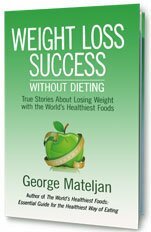|
Check Out What's New On Our Website
We
apologize for any inconvenience you may be experiencing on the website
during our transition to the new design. We are working very hard to
have problems corrected. Find out how to keep your New Year's resolution and lose those extra pounds with our Weight Loss Success-Without Dieting book. Take advantage of our special offer and save $7.00. You pay only $17.00! Find out how to keep your New Year's resolution and lose those extra pounds with our Weight Loss Success-Without Dieting book. Take advantage of our special offer and save $7.00. You pay only $17.00!What's New in 2013
healthy food tip and recipe
Today's Recipe
If you don't know what to serve for dessert tonight ...
This very quick and easy dessert is a great summer recipe because the peaches and blueberries are so delicious when they are in season. They complement each other very well and need no extra sweetening for their flavor to shine. 
Ingredients:
In-Depth Nutritional Profile for Fresh Peaches with Blueberries & Yogurt Healthy Food Tip You recommend canned organic beans in many of your recipes. Yet, isn't there a concern that these cans may contain Bisphenol A (BPA)? To answer your great question and give you guidance as to how you can minimize your exposure to BPA, I wanted to first describe what this compound is including the health effects that it may have. Then we'll explore how common it is in canned foods, specifically organic canned foods, and give you recommendations as to how you may still be able to enjoy the convenience of organic canned beans while promoting your Healthiest Way of Eating.
What is Bisphenol A?
Bisphenol A-often abbreviated as BPA-is a clearly problematic toxin
from the standpoint of the ecosystem and ocean life, and a somewhat
controversial toxin with respect to human health. Known from a chemical
perspective as 2,2-bis(4 hydroxyphenyl)propane, BPA is widely dispersed
in the environment.
There are many potential sources of exposure to BPA completely unrelated to food. BPA is often used in the manufacture of polycarbonates plastics, epoxy resins, and flame-retardant materials. It can be found in adhesives, polycarbonate plastics, automobile parts, laminated products designed to be bullet proof, some fax paper, and some CDs. Within the world of food, two key sources of exposure to BPA are polycarbonate plastic water bottles (usually labeled with the Number 7 recycling symbol), and resin-based can liners that are used to reduce spoilage of canned foods. Baby bottles can also be a problem in terms of BPA exposure.
What health problems are associated with BPA?
BPA is a bioactive compound that is able to bind onto an estrogen
receptor on the nucleus of a cell and modify its function. BPA seems
able to cause changes in some types of cell functions at very similar
concentrations to the naturally produced estrogen molecule called
estradiol. Especially during the fetal period before birth, BPA is of
special concern with respect to later life changes in the risk of
chronic disease, reproductive ability, and cancers of the breast and
prostate. BPA is often referred to as an "endocrine disruptor" because
of its ability to disrupt estrogen receptor activity, alter fertility,
and increase risk of reproductive system-related cancers later in life.
These health dangers posed by BPA exposure are clearly established with
respect to fish and many ocean-living creatures. However, the human
risks involved with exposure to BPA at food-related levels remains a
matter of substantial debate within research studies. Some of the debate
over BPA exposu
re and BPA risk may eventually turn out to hinge upon the health status
of individuals exposed to BPA and their ability or inability to
detoxify this toxin compound. Most of the BPA we get exposed to can be
detoxified through a process called glucuronidation, and individuals can
differ greatly in their ability to carry out this detoxification
process.
How common is BPA in canned foods?
The Environmental Working Group (EWG), a not-for-profit organization
headquartered in Washington, D.C. that routinely issues reports on
food-related toxins in the United States, released a report on bisphenol
A in 2007. (This report can be found on EWG's website at the following
URL address: http://www.ewg.org/reports/bisphenola/execsumm.php).
In laboratory testing of 27 nationally marketed name-brand canned
foods, the EWG found about half of all canned foods (55/97 cans) to
contain BPA. The EWG further estimated that about 10% of all canned
foods contain excessive levels of BPA.
Can canned foods containing BPA be labeled as organic?
To the best of our knowledge, BPA is not a prohibited toxin in the
national organic foods legislation. Because polymers containing BPA are
listed as "inert pesticide ingredients" in the U.S. Environmental
Protection Agency's "List of Inert Pesticide Ingredients" as updated in
August 2004, this potential toxin does not appear to be strictly
prohibited in the canning process used for certified organic foods. For
this reason, unless certified organic canned foods are also explicitly
labeled as "BPA Free" on the can, we do not think you can be certain of
avoiding BPA exposure.
However, it's also important to know that many organic manufacturers have already worked to eliminate BPA from their can liners, and other organic manufacturers are in the process of switching over to cans that are free of BPA. To find out if your favorite canned organic foods are manufactured using BPA-containing cans you will need to call the manufacturer. This will help you determine which products do and do not contain BPA. Of course, another way to be BPA free is to factor in a little more time to your meal preparation process and avoid canned foods altogether by starting with dried (versus canned) beans. | |
“It’s really important that you feel good. Because this feeling good is what goes out as a signal into the universe and starts to attract more of itself to you. So the more you can feel good, the more you will attract the things that help you feel good and that will keep bringing you up higher and higher” – Joe Vitale
Tuesday, June 4, 2013
Fresh Peaches with Blueberries & Yogurt - Healthy Food Tip and Recipe
Subscribe to:
Post Comments (Atom)
God
God, Grant me the serenity to accept the things I cannot change, The courage to change the things I can, The wisdom to know the differen...
-
Having als is no fun. It is a very hard illness to accept. Nothing prepares you for it. Been diagnosed with it almost a year and half ag...
-
I need feedback on which logos you like the best: Image by Cool Text: Free Graphics Generator - Edit Image Image by Cool Text: Free Lo...

No comments:
Post a Comment